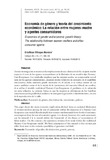Mostrar el registro sencillo del ítem
Economía de género y teoría del crecimiento económico: La relación entre mujeres-madre y agentes consumidores
| dc.rights.license | http://creativecommons.org/licenses/by-nc-sa/3.0/ve/ | |
| dc.contributor.author | Villegas Herrera, Cristhian | |
| dc.date.accessioned | 2013-01-24T10:31:13Z | |
| dc.date.available | 2013-01-24T10:31:13Z | |
| dc.date.issued | 2013-01-24T10:31:13Z | |
| dc.identifier.issn | 1315-2467 | |
| dc.identifier.uri | http://www.saber.ula.ve/handle/123456789/36463 | |
| dc.description.abstract | En esta investigación se muestran las implicaciones de una distinción de las mujeres-madre respecto al resto de los agentes consumidores en la dinámica de un modelo tipo Ramsey- Cass-Koopmans. Los resultados implican que las mujeres-madre, en comparación con el resto de los agentes consumidores, alcanzan niveles inferiores de consumo en el equilibrio estacionario; dicha asimetría puede mermarse vía el salario si se trabaja dentro de un marco analítico como el de la teoría de la inexistencia del mercado laboral; en cambio, si se utiliza el modelo tradicional Ramsey-Cass-Koopmans, el problema en la asimetría no tiene solución. La premisa básica es que las mujeres se diferencian de los hombres únicamente por la posibilidad exclusiva de estas para la gestación y alumbramiento, en aras de la reproducción de la vida. | es_VE |
| dc.language.iso | es | es_VE |
| dc.rights | info:eu-repo/semantics/openAccess | |
| dc.subject | Economía de género | es_VE |
| dc.subject | Discriminación | es_VE |
| dc.subject | Crecimiento | es_VE |
| dc.subject | Pobreza | es_VE |
| dc.title | Economía de género y teoría del crecimiento económico: La relación entre mujeres-madre y agentes consumidores | es_VE |
| dc.title.alternative | Economics of gender and economic growth theory: The relationship between women-mothers and other consumer agents | es_VE |
| dc.type | info:eu-repo/semantics/article | |
| dc.description.abstract1 | This paper shows the main economic implications derived from an analytical distinction of women-mothers among the rest of consumers within the dynamics of a Ramsey-Cass Koopmans type model. Results imply that women-mothers reach lower levels of stationary consumption than the rest of economic agents. It is shown, however, that such asymmetry can be reduced if it is treated within the framework of the theory of nonexistence of labor market. On the contrary, the asymmetry remains if we work within the traditional Ramsey-Cass-Koopmans model. The basic assumption of this research is that women just differ from men in the exclusive possibility of gestation and birth. | es_VE |
| dc.description.colacion | 65-83 | es_VE |
| dc.description.email | cristhian_ villegas_herrera@hotmail.com | es_VE |
| dc.description.frecuencia | semestral | |
| dc.identifier.depositolegal | 198702me336 | |
| dc.subject.facultad | Facultad de Ciencias Económicas y Sociales | es_VE |
| dc.subject.institutoinvestigacion | Instituto de Investigaciones Económicas y Sociales (IIES) | |
| dc.subject.keywords | Economics of gender | es_VE |
| dc.subject.keywords | Discrimination | es_VE |
| dc.subject.keywords | Growth | es_VE |
| dc.subject.keywords | Poverty | es_VE |
| dc.subject.publicacionelectronica | Revista Economía | |
| dc.subject.seccion | Revista Economía: Artículos | es_VE |
| dc.subject.thematiccategory | Ciencias Económicas y Sociales | es_VE |
| dc.subject.tipo | Revistas | es_VE |
| dc.type.media | Texto | es_VE |
Ficheros en el ítem
Este ítem aparece en la(s) siguiente(s) colección(ones)
-
Economía - Nº 033
enero - junio 2012


